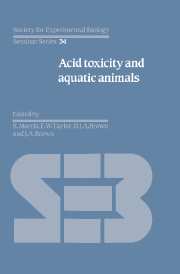Book contents
- Frontmatter
- Contents
- Contributors
- Units, Symbols and Formulae
- Preface
- Introduction: The causes and consequences of surface water acidification
- Invertebrate communities in acid streams
- Fish survival in acid waters
- Field studies on fisheries in acid waters in the UK
- Episodic changes in water quality and their effects on fish
- Acid–base regulation in fishes: 1. Mechanisms
- Acid–base regulation in fishes: 2. Biological responses and limitations
- Intracellular pH regulation and the effects of external acidification
- The physiological problems of fish in acid waters
- Laboratory studies on invertebrate survival and physiology in acid waters
- The physiological problems of crayfish in acid waters
- The effects of hydrogen and aluminium ions on fish gills
- The combined effects of pH and trace metals on fish ionoregulation
- Endocrine responses to acid stress in fish
- Commentary and conclusions
- Index
Laboratory studies on invertebrate survival and physiology in acid waters
Published online by Cambridge University Press: 05 February 2012
- Frontmatter
- Contents
- Contributors
- Units, Symbols and Formulae
- Preface
- Introduction: The causes and consequences of surface water acidification
- Invertebrate communities in acid streams
- Fish survival in acid waters
- Field studies on fisheries in acid waters in the UK
- Episodic changes in water quality and their effects on fish
- Acid–base regulation in fishes: 1. Mechanisms
- Acid–base regulation in fishes: 2. Biological responses and limitations
- Intracellular pH regulation and the effects of external acidification
- The physiological problems of fish in acid waters
- Laboratory studies on invertebrate survival and physiology in acid waters
- The physiological problems of crayfish in acid waters
- The effects of hydrogen and aluminium ions on fish gills
- The combined effects of pH and trace metals on fish ionoregulation
- Endocrine responses to acid stress in fish
- Commentary and conclusions
- Index
Summary
Introduction
Although most attention has been focused on the impoverishment of fish populations in acidified lakes, numerous ecological studies have shown that phytoplankton, zooplankton and benthic invertebrates have decreased in diversity in recently acidified waters. There is ample evidence to suggest that the pH is a major variable in determining the distribution of species, although recent work includes other parameters, like the Ca2+ content and the metal concentrations into the list of distribution-limiting factors. Very elegant work in this respect has been performed by Økland and Økland (Økland, J., 1980; Økland, K.A., 1980; Økland & Økland, 1980) who studied in detail the gastropod fauna in acid-polluted and non-polluted lakes in Norway. The literature describing in situ studies of the pH influence on invertebrate distribution, mortality and diversity, being large and quite impressive, will not be quoted in detail in this text, and the reader is advised to study the reports of the SNSF Project in Norway (Leivestad et al., 1976; Overrein et al., 1980), or the review paper of Sutcliffe & Hildrew (this volume) covering the subject.
Laboratory experiments on mortality of freshwater fauna reveal clearly that there exists a critical pH value below which survival is significantly reduced. This critical value is species-dependent but it is also determined by the composition of the testwater.
- Type
- Chapter
- Information
- Acid Toxicity and Aquatic Animals , pp. 153 - 170Publisher: Cambridge University PressPrint publication year: 1989
- 14
- Cited by



